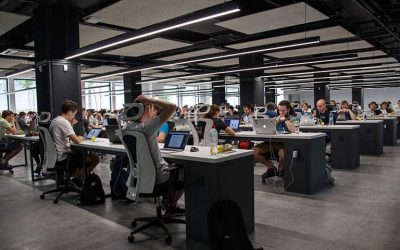Types of Lighting Systems
Understanding the different lighting systems is the first step in developing an effective maintenance strategy. Large facilities often use a mix of lighting types, each with distinct characteristics:
- Incandescent Lighting: Known for warm lighting but less energy-efficient and has a shorter lifespan. Mostly used for specific or accent lighting.
- Fluorescent Lighting: Common in commercial spaces, offering energy efficiency and longevity. Requires ballasts to regulate power.
- LED Lighting: Highly energy-efficient and long-lasting, LEDs have become the standard in modern facilities. They offer minimal maintenance needs and reduced energy consumption.
- HID (High-Intensity Discharge) Lighting: Used for large spaces such as warehouses and gymnasiums. Although effective for large areas, HID lights are known for higher maintenance needs and shorter lifespans than LEDs.
Each system has unique components, like ballasts, drivers, and various control options, which require regular attention to ensure optimal performance.
Did you know we have a Lighting and LED Education Center? We have interactive education pages for most types of lighting. You will find in-depth reviews, with pros, cons, and comparisons between lighting types. You can learn more here!
Common Lighting Issues in Large Facilities
Without regular preventive lighting maintenance, facilities often face several lighting-related issues:
- Flickering Lights: Often due to aging bulbs, poor electrical connections, or faulty ballasts. Flickering lights can create distractions and indicate deeper electrical issues.
- Dimming or Inconsistent Light Levels: Fluctuating voltage, faulty drivers, or poor wiring can cause dim lights, affecting visibility and productivity.
- Overheating Fixtures: Caused by electrical overload or incorrect bulb wattage, overheating can be hazardous.
- Premature Burnout of Lamps: This can happen due to high voltage, vibration, or inappropriate usage, particularly with incandescent or halogen bulbs.
- Reduced Energy Efficiency: As lamps age, they may consume more power for the same light output, leading to increased energy costs.
Addressing these issues proactively with lighting preventive maintenance minimizes disruptions and prolongs the system’s lifespan.
Goals of Lighting Maintenance
Optimize Energy Efficiency
Lighting maintenance plans are a key strategy to optimizing energy efficiency through your lighting fixtures. As lighting reaches the end of its lifespan, it can begin to malfunction by losing its brightness and consuming more energy to keep powering. By checking lighting fixtures through a set schedule, it can reduce the amount of energy being used through lighting.
Improve Safety and Security
The main priority for any workplace should be the safety of its employees. In a large facility, especially industrial facilities, proper lighting plays an important part in keeping everybody safe. When lighting fixtures go out, employees are at risk of accidents or injuries on the job. When facilities stick to a maintenance plan, lighting will be replaced before it dies out to keep consistent visibility. These plans also include emergency lighting to ensure safe exits during emergencies and outages. Lighting maintenance plans lead to an overall safer environment.
Reduce Costs and Extend Lifespan
By being proactive with maintenance checks, it can prevent more serious problems that could arise. This includes pinpointing when lamps are reaching the end of their lifecycle, replacing lights with a more efficient option, or noticing when lighting is not working to its fullest potential. Fixing lighting issues in advance prevents bigger electrical problems that lead to lighting outages, high maintenance costs associated and can extend the lifespan of the lighting system.
Lighting Maintenance Procedures
To achieve these goals, specific maintenance procedures should be regularly performed:
- Routine Cleaning of Lamps and Fixtures: Dust and debris can reduce light output and lead to overheating.
- Scheduled Lamp Replacement: Group relamping helps prevent random failures and reduces labor costs associated with frequent replacements.
- Inspection of Electrical Components: Regularly inspect ballasts, drivers, and connections for signs of wear or malfunction.
- Control System Testing: Test timers, sensors, and dimmers to ensure they work efficiently and as scheduled.
- Emergency Lighting Verification: Regularly check that emergency lights activate, and work as intended during power outages.
These preventive measures are crucial to maintaining a consistent, reliable lighting environment.
Checklist for Developing a Lighting Maintenance Plan
Creating a structured checklist helps streamline lighting preventive maintenance and ensures consistency. Here’s a suggested checklist for large facilities:
Weekly
- Visual Inspection: Check fixtures and connections for damage, wear, or physical issues.
- Lamp Functionality: Test all lights, including outdoor ones, and replace any that are burnt out or flickering.
Monthly
- Cleaning and Dusting: Dust indoor and outdoor fixtures to maintain maximum illumination.
- Wiring and Connections: Inspect for wear, damage, or loose connections and repair as needed.
Quarterly
- Control Systems Testing: Verify that all lighting controls, like switches, dimmers, and timers, are operational.
- Ballast and Driver Inspection: Check for buzzing or overheating and replace any damaged components.
Annually
- Proactive Lamp Replacement: Based on lifespan predictions, replace lamps to avoid unplanned outages.
- Energy Efficiency Review: Assess energy consumption and consider upgrading to more efficient options if needed.
- Emergency Systems Check: Ensure emergency lighting and exit signs are functional and unobstructed.
Documentation
- Maintenance Records: Maintain a log of inspections, repairs, and upgrades. Documentation helps track performance and spot recurring issues.
Preventative Maintenance with Action Services Group
By partnering with Action Services Group, you can streamline the preventative maintenance process and get expert advice on developing a maintenance plan. As a national provider of turn-key lighting services, we can provide lighting maintenance based on your budget, schedule and lighting needs. To speak with one of our specialists, call 610-558-9773, email [email protected], or schedule a call that fits your needs by clicking the button below.









































0 Comments